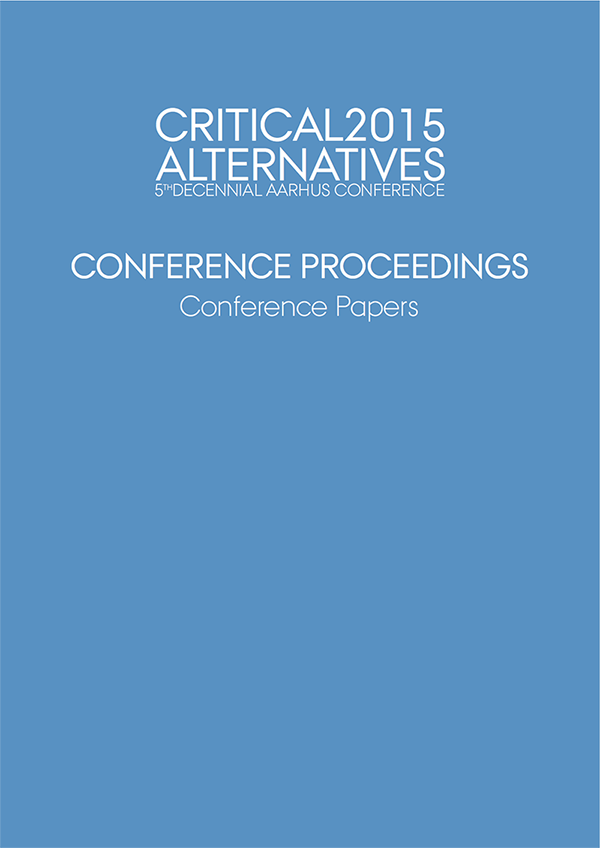Embodying Embodied Design Research Techniques
DOI:
https://doi.org/10.7146/aahcc.v1i1.21620Keywords:
Embodied design, embodied ideation, embodied interaction, research processes, reporting methods, wearable technology, video capture, quantified selfAbstract
The value of engaging the full gamut of sensory motor skills in the design and use of smart objects and systems is recognized. Yet methods for arriving at robust and reliable outcomes for their development are not fully understood, nor are they easily reported or transferred through typical conference presentations and paper submissions. New forms of knowledge transfer, such as pictorials (e.g., DIS and RTD conferences), and video are enabling enhanced, image-enriched reporting of outcomes. Y et appropriate transfer of embodied research methods remains elusive.
In this workshop we propose to investigate how embodied research techniques may be used as direct and unmediated vehicles for their own reporting. Rather than engaging in oral presentations, participants will lead other participants through a proven embodied method or approach. Small groups will create mash-ups of techniques, exploring ways that the new approaches might coherently be reported. Participants will be encouraged to experiment with different recording techniques, including body-mounted sensing and recording devices, as well as less conventional approaches. The intention is to find appropriate ways of reporting embodied experiments, so that intangible elements are not lost. Participants will be supported to reflect on unfolding discoveries, to share impressions, as well as outcomes, including documentation experiments that aim to tangibly capture and communicate the processes undertaken.
Embodied ideation, communication and collaboration techniques enable enhanced creative engagement and assist creativity [2]. By applying such methods to the problem of their reporting, we hope to deepen understanding of how to move towards enriched, nuanced and repeatable methods for embodied design and knowledge transfer. Crucially, our intention is not simply to find the next form of research reporting. Rather, this workshop will engage participants in an experimental enquiry, so that embodied design research may become an active area of inquiry moving forward.
References
Bencina, R., Wilde, D., Langley, S. Gesture ≈ Sound Experiments: Process and Mappings Proc. NIME 2008, ACM Press (2008).
Buur, J., Torguet, R. Ethnographic Findings in the Organizational Theatre. Proc. EPIC 2013.
Corness, G. & Schiphorst, T. Performing with a system's intention: embodied cues in performer-system interaction. Proc. C&C 2013, ACM (2013), 156-164
Djajadiningrat, T., Matthews, B., and Stienstra, M. Easy doesn’t do it: skill and expression in tangible aesthetics. Pers. & Ubiq. 11, 8 (2007), 657-676.
Gallagher, S. How The Body Shapes the Mind. Clarendon Press, Oxford, UK, 2005
Hansen, L.K. & Kozel, S. Embodied imagination: a hybrid method of designing for intimacy. Digital Creativity, 18(4) (2007), 207-220.
Hummels, C., Overbeeke, C. J. and Klooster, S. Move to get moved: a search for methods, tools and knowledge to design for expressive and rich movement-based interaction. Pers. & Ubiq. 11, 8 (2007), 677-690.
Jeon, E. ‘Enriched Aesthetic Interaction’ through sense from haptic visuality. Proc. IDA Congress Education Conference (2011), 28-35.
Johnstone, K., Impro: Improvisation and the Theatre. Routledge, 1987
Kirsh, D. Thinking with the Body. Proc. Cognitive Science Society (2010), 2864-2869.
Kozel, S. Closer: Performance, Technologies, Phenomenology. Cambridge: MIT Press, 2008
Kozel, S. The virtual and the physical: A phenomenological approach to performance research. In M. Biggs and H. Karlsson (Eds.) The Routledge Companion in Research in the Arts, 2010.
Loke, L., Robertson, T. Moving and making strange. ToCHI 20(1), Article 7, 2013
Moen, J. Kinaesthetic Movement Interaction. PhD diss., KTH Royal Institute of Technology, Sweden, 2006.
Personal & Ubiquitous Computing Special issue on movement-based interaction 11(8), Springer, 2007.
Ross, P., & Wensveen, S. (2010). Designing aesthetics of behavior in interaction: Using aesthetic experience as a mechanism for design. IJD, 4(2), 3-13, 2010.
Ryan, J. Knowing When, in The Vibrancy Effect ed. Chris Salter. Rotterdam: V2_ Publishing, 2011.
Schiphorst, T. Andersen, K. Between bodies: Using experience modeling to create gestural protocols for physiological data transfer. Proc. CHI 2004 Fringe Papers. ACM Press, 2004.
Schiphorst, T., Sheppard, R., Loke, L., Lin, C. (2013) Beautiful Dance Moves. Proc. C&C 2013. ACM Press, 2013.
Shusterman, R. Body Consciousness: A Philosophy of Mindfulness and Somaesthetics. Cambridge University Press, 2008.
Stjernholm, J. Moving through the virtual: A dramaturgy of choreographic practice and perception. Dance Dramaturgy: Catalyst, Perspective and Memory. Proc. Society of Dance History Scholars Conference, SDSH, 2011.
Sundström, P., Vaara, E., Solsona, J., Wirström, N., Lundén, M., Laaksolhati, J., Waern, A., Höök, K. (2011) Experiential Artifacts as a Design Method for Somaesthetic Service Development. Proc. 2011 ACM symposium on The role of design in UbiComp research & practice. Ubicomp 2011, 33-36 ACM Press, 2011.
ToCHI Transactions on Computer Human Interaction Special issue on the theory and practice of embodied interaction. ToCHI 20(1), ACM Press, 2013.
Uğur, S. Wearing Embodied Emotions, A Practice Based Design Research on Wearable Technology. Springer, 2013.
Wilde, D. Swing That Thing : Moving to move. PhD Diss., Monash University & CSIRO, Australia, 2012.
Wilde, D. Schiphorst, T. Klooster, S. Move to Design • Design to Move: a conversation about designing for the body. Interactions 18(4) ACM Press, 2011.
Ylirisku, S. P., Buur, J. Designing with Video. Springer Verlag. 2007.




